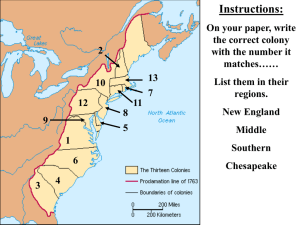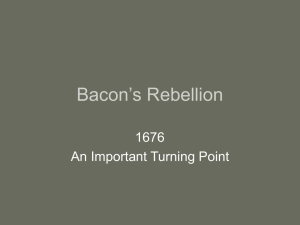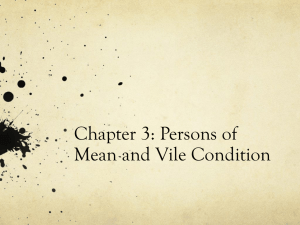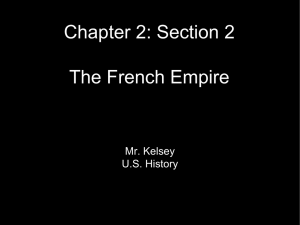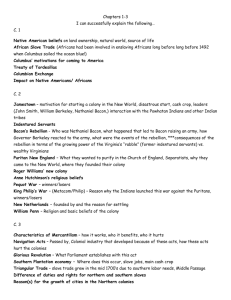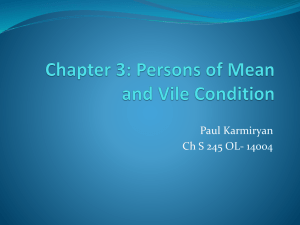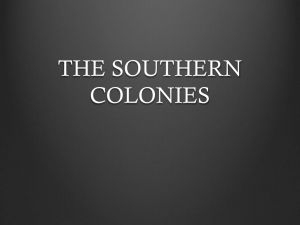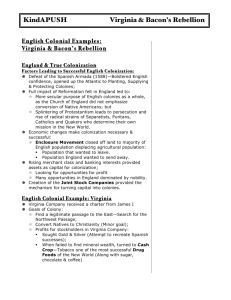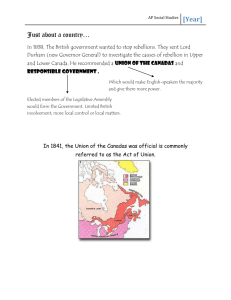Bacon's Rebellion - World History: The Big Eras
advertisement
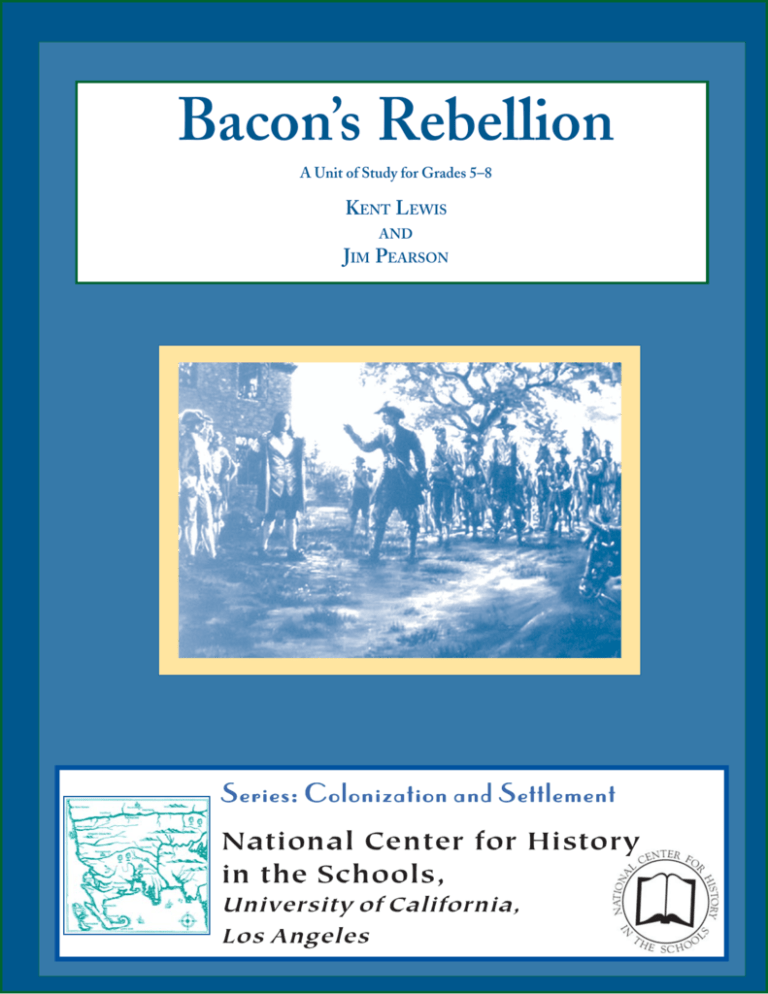
Bacon’s Rebellion A Unit of Study for Grades 5–8 KENT LEWIS AND JIM PEARSON Series: Colonization and Settlement National Center for History in the Schools, University of California, Los Angeles NATIONAL CENTER FOR HISTORY IN THE SCHOOLS University of California, Los Angeles This pdf was prepared exclusively for preview purposes and may not be resold or redistributed. Thank you for your cooperation! To purchase copies: nchs@history.ucla.edu TEACHER BACKGROUND I. Unit Overview T his unit explores Virginia society between 1640 and 1680. By examining copies of original documents, students will study the causes of Bacon’s Rebellion in 1676. Although the rebellion was a failure, understanding the reasons for the conflict gives insight into colonial Virginia. Students will learn that Virginia was initially a predominantly male society of fortune hunters, who, when gold was not discovered, settled on tobacco as the quickest and surest way to riches. It was a highly stratified society with large numbers of indentured servants. In part, Bacon’s Rebellion reflected the lower orders’ resentment at their place in this hierarchical society. The unit will also show how the thirst for land fueled a hatred of American Indians and led to the indiscriminate assault on both friendly and hostile tribes. Finally, the unit gives insight into why the Southern colonies shifted from white bound labor to black slave labor. Elementary school children should understand that the regional differences that continue to influence our nation began in colonial America. Studying Bacon’s Rebellion will help students understand colonial Virginia and the ways in which it was distinct from New England and the Middle colonies. The families and cooperative community values that marked the New England colonies were only weakly present in Virginia. A study of Bacon’s Rebellion will also help students understand that there were choices in the way white and Indian cultures interacted. One of the central issues of Bacon’s Rebellion was the struggle over the way Indians should be treated. The systematic extermination of Indian groups and the destruction of their cultures were not inevitable. This unit will help explain, but not excuse, the choice the white settlers of Virginia made. Additionally, this unit suggests part of the reason African slaves eventually replaced English and Irish bonded servants as the primary labor force in the Southern colonies. The rebellion revealed the drawback of relying on a labor force based on bonded servants. Such servitude fostered resentment which masters could only control while the laborers were in service. Once servants became freemen, planters were no longer able to compel subservience; indeed, former servants competed with planters for land and labor. Finally, studying the struggle between Bacon and Berkeley, neither of whom was particularly admirable, allows children to grapple with the possibility that sometimes neither side in a contest is endowed with particular virtue. II. Unit Context T his unit on Bacon’s Rebellion should be taught after units on American Indians, European exploration, Jamestown’s founding and the Puritans in the Massachusetts Bay Colony. On the basis of earlier lessons and the completion of this one, students should be able to compare and contrast New England colonies Bacon’s Rebellion 3 Teacher Background with southern colonies like Virginia. This unit also anticipates and partially prepares students for later study of Indian-white relations, westward expansion, slavery, and the Revolutionary War. When studying these areas teachers should draw on what students learned while studying Bacon’s Rebellion to reinforce and enhance their understanding. III. Unit Objectives IV. ♦ To study historical documents, in order to experience history as a dynamic discipline which studies, interprets, and debates the meaning of human artifacts and, through those remnants, humanity’s collective past. ♦ To explain what an indentured servant was and contrast indentured servitude with slavery. ♦ To contrast gentlemen and freemen, noting the legal distinctions between them. ♦ To explain the social and legal status of slaves, servants, freemen, and gentlemen. ♦ To examine the American Indians’ inferior status in the colonists’ legal system. ♦ To explain the attitude of colonists like Nathaniel Bacon toward American Indians and how their attitudes differed from colonists like Governor Berkeley. ♦ To make reasonable speculations about how the different orders of Virginia society felt about their respective conditions. ♦ To speculate about why planters would want slaves instead of bound or free labor. Correlation to National Standards for United States History Bacon’s Rebellion provides teaching materials to support the National Standards for History, Basic Edition (National Center for History in the Schools, 1996), Era 2, Colonization and Settlement (1585–1763). Lessons within this unit assist students in attaining Standard 2A by explaining the social, economic, and political tensions that led to violent conflicts between the colonists and their governments. 4 Bacon’s Rebellion Teacher Background V. Introduction to “Bacon’s Rebellion” I n 1675 and 1676, the Jamestown colony was torn by conflict. War between American Indians and colonists led to civil war within the colony. Since 1646 a treaty which gave the Powhatan Indians exclusive rights to land north of the York River had kept relations between the Indians and Virginians calm. The established settlers and Governor Berkeley, who controlled the Indian trade, wanted to maintain good relations with Indians and avoid conflict. But new settlers and white indentured servants who had served their time, were hungry for Indian land. In the summer of 1675 a group of frontiersmen found an excuse to attack the Susquehannocks, whose land they coveted. Although the governor tried to keep peace, few settlers supported him and both sides prepared for war. Militarily weak but feeling wronged and wanting revenge, the Susquehannocks attacked during the winter of 1675-1676, killing thirty-six Virginians. That spring, the frontiersmen, led by Nathaniel Bacon, launched a campaign of indiscriminate warfare against friendly and unfriendly Indians. Ignoring the frontiersmen’s petitions for support and infuriated by their blatant disregard of his order to desist, the governor sent 300 militiamen to bring Bacon to Jamestown. Bacon’s war on the American Indians had become a civil war. Virginians rebelled for various reasons: class resentment, desire for personal gain, hatred of Indians, and anger with the governor’s rule. Although Berkeley had raised taxes and limited the authority of local officials, it was conciliatory Indian policy that provoked the insurrection. The rebellion achieved initial success, probably drawing the support of the majority of colonists. Continuing to attack Indians indiscriminately rebels also out-maneuvered Berkeley’s troops, capturing and burning Jamestown, the capital. But the rebellion fizzled as rapidly as it had begun. As the Indians were subdued, rebels drifted back to their farms. Bacon’s death by dysentery drained the rebellion of its remaining momentum. The arrival of 1,100 troops from England in January 1678 sealed the end of the revolt. Besides marking the point when unrelenting persecution of American Indians became standard practice among colonists, Bacon’s Rebellion helps explain why enslaved African laborers ultimately supplanted white bonded servants as the primary labor force in the Southern colonies. In the early days of settlement bonded servants were the preferred source of labor. Servants brought to Virginia allowed planters to reap a double benefit: not only did planters get several years’ worth of cheap labor, but they were given fifty acres for each new settler they brought to Virginia. Both bonded servants and slaves initially had very high mortality rates. Since servants were cheaper than slaves and both were likely to die within a few years of arrival, servants were the better bargain. But eventually, as people learned to survive in this new land, servants began to live long enough to achieve freedom. These people, anxious for their own farms, put pressure on the colonial government to expand westward into American Indian lands. They also became undesirable competitors to the already established planters. Bacon’s Rebellion 5 Teacher Background Bacon’s Rebellion was an indication that a labor force which could eventually challenge the authority of the planters was not desirable. As this demand for a different form of labor was growing, a new labor supply emerged. The African slave trade that had formerly been controlled by the Dutch was now in the hands of the English and would soon supply a more tractable and subservient labor force. VI. 6 Lesson Plans 1. What Was it Like to be an Indentured Servant? 2. Were There Different Classes of People in Virgina? 3. Relations Between White Colonists and American Indians 4. The Causes of Bacon’s Rebellion Bacon’s Rebellion DRAMATIC MOMENT The Revolt Of 1676 O n September 19, 1676, Governor Berkeley of Virginia, still vigorous despite his nearly seventy years, felt alone and afraid as he stared at the petition his officers had presented urging that they abandon Jamestown. The Governor’s men, badly outnumbered and unsure of their own cause, wanted to retreat. Yet to give up Jamestown, the capital and largest town of the colony, to the young traitor Nathaniel Bacon, and his rag tag army of rabble, might mean the loss of Virginia as a colony. Armed ships were on the way from England, but his own men had no stomach to fight Bacon or his army. Nathaniel Bacon had been in Virginia for less than three years but had become a hero to many of the colony’s poor freemen. Not that Bacon himself was poor—far from it. He was the son of a wealthy English gentleman who, having tired of his son’s extravagant and reckless antics, shipped him to Virginia with enough money to establish a large tobacco plantation. In Virginia, Bacon was welcomed by the Governor, his cousin by marriage, and the other rich planters of the colony. His wealth, high birth, and ability to speak persuasively led Governor Berkeley to appoint him to the council of state less than a year after his arrival. But Bacon’s popularity among the poor and common people of Virginia was not due to his rank, but because he was an outspoken enemy to all Indians. The captured Indians he paraded in front of the barricades surrounding Jamestown the day before were a reminder to the loyalists of what had caused the rebellion. Although he was attacking the capital, he had frequently insisted that his only intention was to protect the frontier regions from the threat of Indians. Reluctantly, the Governor accepted the pleas of his officers and troops. He ordered his men onto the ships in the harbor. That night, Berkeley’s men in their ships on the James River watched their capital, the first permanent English settlement in the New World, being burned and utterly destroyed. Just over a month after this night, Bacon would die of what was then called bloody flux (dysentery). The loss of their charismatic leader led to the rapid collapse of the rebellion. Bacon’s Rebellion 7
